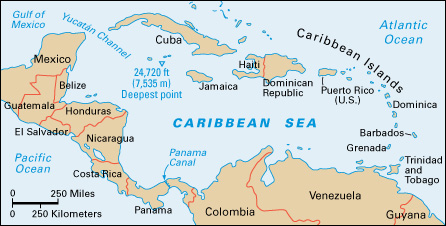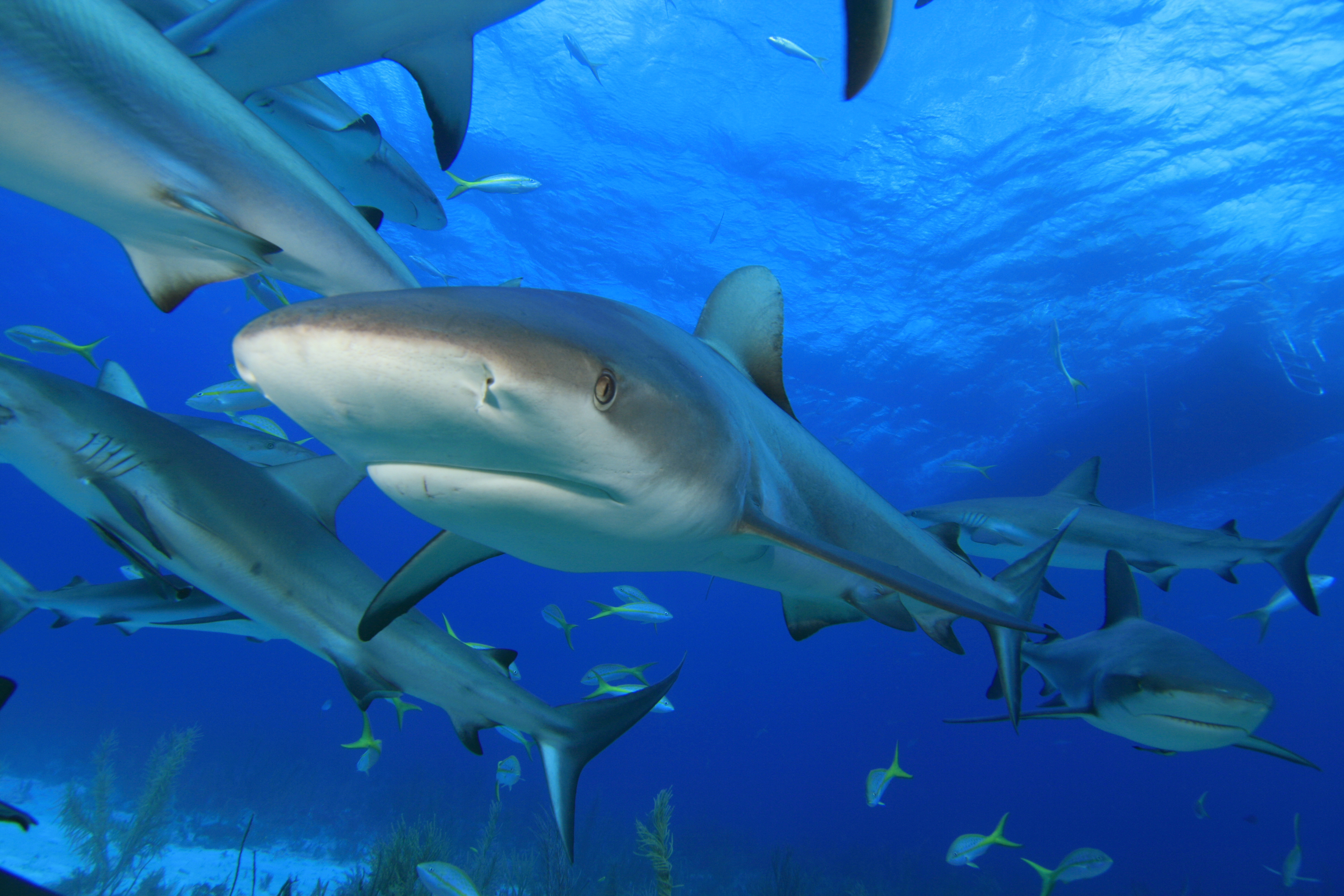Caribbean << `kar` uh BEE uhn or kuh RIHB ee uhn >> Sea is a part of the Atlantic Ocean southeast of the United States. It is the Atlantic’s largest marginal sea. A marginal sea is partially isolated from a major ocean basin by surrounding land masses. The land masses that separate the Caribbean Sea from the ocean basin are the Greater Antilles islands, to the north; the Lesser Antilles islands, to the east; and South America, to the south. To the west, Central America separates the Caribbean Sea from the Pacific Ocean basin. The Greater and Lesser Antilles form a barrier that limits the exchange of water between the Caribbean Sea and the North Atlantic Ocean. As a result, the Caribbean has a marine environment different from that of the rest of the Atlantic.

The Caribbean Sea is about 1,700 miles (2,740 kilometers) long from west to east and from 500 to 800 miles (800 to 1,300 kilometers) wide from north to south. Its greatest depth is about 24,720 feet (7,535 meters). At 1.55 million cubic miles (6.46 million cubic kilometers), the total volume of the Caribbean is about double that of the Mediterranean Sea.
Climate and geology.
The climate of the Caribbean Sea is generally hot and humid. Trade winds from the east create a consistent breeze across the sea (see Trade wind). During the summer and early autumn, hurricanes often form in the region. The part of Earth’s crust under the Caribbean Sea is a tectonically active area—that is, a place where rigid tectonic plates that make up Earth’s rocky outer shell meet. The slow movement of these huge plates in relation to each other causes the formation of ocean ridges and trenches, volcanic islands, and other geographical features. Plate movement also may cause earthquakes, volcanic eruptions, and destructive waves called tsunamis.
Some Caribbean islands, such as the Lesser Antilles, were formed by plate movement. Others, such as the Cayman Islands south of Cuba, are carbonate islands. They formed when calcium carbonate, or limestone, gathered in shallow areas. Caribbean waters contain a number of coral reefs, which are also shaped by limestone formations. The barrier reefs of the Bahamas and those in the western Caribbean Sea are the largest in the region.
People and wildlife.
The Caribbean is one of the most culturally and ethnically diverse areas of the world. The region is home to people of African, American, Asian, and European background. This mixture of cultures has resulted in unique dialects (language variations); such musical styles as calypso, reggae, soca, son, and steel band music; and such religions as Vodou (sometimes called Voodoo), Santería, and Rastafarianism.
The Caribbean islands are home to many animals and plants found nowhere else in the world. For instance, dozens of species of butterflies are unique to the island of Hispaniola. Many birds that migrate between North and South America visit the Caribbean islands.

Currents.
The confluence (coming together) of two ocean currents, the Guiana Current and the North Equatorial Current, carries water northwest toward the Caribbean Sea. The flow from these currents is split into two branches by the Lesser Antilles islands. One branch, the Caribbean Current, flows northwest between the Lesser Antilles. It flows through the Caribbean Sea and then through the Gulf of Mexico into the Straits of Florida. There, it helps form the Florida Current and becomes part of the Gulf Stream. The other branch, the Antilles Current, travels northward along the eastern side of the Lesser Antilles and eventually merges with the Florida Current to the north.
Economic importance.
The location of the Caribbean Sea near America has made it economically and politically important throughout history. During the 1500’s and 1600’s, many pirates and privateers sailed the Caribbean, plundering cargo ships. Privateers were licensed by a particular nation during wartime to attack enemy ships. Some infamous pirates to sail the Caribbean during this period were Sir Henry Morgan, Sir Francis Drake, “Calico Jack” Rackham, and Anne Bonny. See Pirate (The Caribbean).
Today, cargo ships sail the Caribbean carrying sugar, petroleum, coffee, bananas, and other goods from America to other parts of the world. Cruise ships also frequent the Caribbean Sea and stop at such ports as Cozumel, Mexico; Ocho Rios, Jamaica; and Puerto Plata, in the Dominican Republic.
See also Caribbean Islands.
